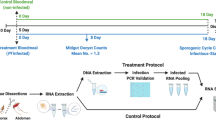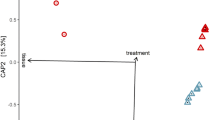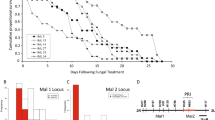Abstract
Efficiency of mosquito-borne disease transmission is dependent upon both the preference and fidelity of mosquitoes as they seek the blood of vertebrate hosts. While mosquitoes select their blood hosts through multi-modal integration of sensory cues, host-seeking is primarily an odor-guided behavior. Differences in mosquito responses to hosts and their odors have been demonstrated to have a genetic component, but the underlying genomic architecture of these responses has yet to be fully resolved. Here, we provide the first characterization of the genomic architecture of host preference in the polymorphic mosquito species, Culex pipiens. The species exists as two morphologically identical bioforms, each with distinct avian and mammalian host preferences. Cx. pipiens females with empirically measured host responses were prepared into reduced representation DNA libraries and sequenced to identify genomic regions associated with host preference. Multiple genomic regions associated with host preference were identified on all 3 Culex chromosomes, and these genomic regions contained clusters of chemosensory genes, as expected based on work in Anopheles gambiae complex mosquitoes and in Aedes aegypti. One odorant receptor and one odorant binding protein gene showed one-to-one orthologous relationships to differentially expressed genes in A. gambiae complex members with divergent host preferences. Overall, our work identifies a distinct set of odorant receptors and odorant binding proteins that may enable Cx. pipiens females to distinguish between their vertebrate blood host species, and opens avenues for future functional studies that could measure the unique contributions of each gene to host preference phenotypes.
This is a preview of subscription content, access via your institution
Access options
Subscribe to this journal
Receive 12 print issues and online access
$259.00 per year
only $21.58 per issue
Buy this article
- Purchase on Springer Link
- Instant access to full article PDF
Prices may be subject to local taxes which are calculated during checkout



Similar content being viewed by others
Data availability
Data for this study are available at: http://www.ncbi.nlm.nih.gov/bioproject/1068091. All scripts used to perform these analyses can be found at: https://github.com/katebell1987/CulexMS1 or upon request from corresponding authors.
References
Ambrose L, Popovic I, Hereward J, Ortiz-Barrientos D, Beebe NW (2022) Comparisons of chemosensory gene repertoires in human and non-human feeding Anopheles mosquitoes link olfactory genes to anthropophily. iScience 25:104521
Apperson HK et al. (2004) Host feeding patterns of established and potential mosquito vectors of West Nile virus in the Eastern United States. Vector Borne Zoonotic Dis 4:71–82
Asgharian H et al. (2015) Evolutionary genomics of Culex pipiens: global and local adaptations associated with climate, life-history traits and anthropogenic factors. Proc R Soc B Biol Sci 282:20150728
Auer TO, Alvarez-Ocana R, Cruchet S, Benton R, Arguello JR (2022) Copy number changes in co-expressed odorant receptor genes enable selection for sensory differences in drosophilid species. Nat Ecol Evol 6:1343–1353
Barr AR (1967) Occurrence and distribution of the Culex pipiens complex. Bull World Health Organ 37:293
Beissinger TM, Rosa GJ, Kaeppler SM, Gianola D, de Leon N (2015) Defining window-boundaries for genomic analyses using smoothing spline techniques. Genet Sel Evol 47:1–9
Besansky NJ et al. (1994) Molecular phylogeny of the Anopheles gambiae complex suggests genetic introgression between principal malaria vectors. Proc Natl Acad Sci 91:6885–6888
Brugman VA et al. (2018) The role of Culex pipiens L.(Diptera: Culicidae) in virus transmission in Europe. Int J Environ Res Public Health 15:389
Capblancq T, Forester BR (2021) Redundancy analysis: a Swiss army knife for landscape genomics. Methods Ecol Evol 12:2298–2309
Capblancq T, Luu K, Blum MG, Bazin E (2018) Evaluation of redundancy analysis to identify signatures of local adaptation. Mol Ecol Resour 18:1223–1233
Chaturvedi S et al. (2020) Recent hybrids recapitulate ancient hybrid outcomes. Nat Commun 11:2179
Cheek RG et al. (2022) Habitat-linked genetic variation supports microgeographic adaptive divergence in an island-endemic bird species. Mol Ecol 31:2830–2846
Christophers SR (1960) Aedes aegypti: the yellow fever mosquito. CUP Archive
Coluzzi M, Sabatini A, Petrarca V, Di Deco M (1979) Chromosomal differentiation and adaptation to human environments in the Anopheles gambiae complex. Trans R Soc Trop Med Hyg 73:483–497
Crawford JE et al. (2017) Population genomics reveals that an anthropophilic population of Aedes aegypti mosquitoes in west Africa recently gave rise to American and Asian populations of this major disease vector. BMC Biol 15:1–16
Crutzen PJ (2006) The “Anthropocene”. In: Ehlers E, Krafft T (eds) Earth system science in the Anthropocene, Springer, pp 13–18
DeGennaro M et al. (2013) orco mutant mosquitoes lose strong preference for humans and are not repelled by volatile DEET. Nature 498:487–491
Dekker T, Takken W (1998) Differential responses of mosquito sibling species Anopheles arabiensis and An. quadriannulatusto carbon dioxide, a man or a calf. Med Vet Entomol 12:136–140
Dekker T, Takken W, Cardé RT (2001) Structure of host-odour plumes influences catch of Anopheles gambiae ss and Aedes aegypti in a dual-choice olfactometer. Physiol Entomol 26:124–134
Dworkin I, Jones CD (2009) Genetic changes accompanying the evolution of host specialization in Drosophila sechellia. Genetics 181:721–736
Falush D, Stephens M, Pritchard JK (2003) Inference of population structure using multilocus genotype data: linked loci and correlated allele frequencies. Genetics 164:1567–1587
Farajollahi A, Fonseca DM, Kramer LD, Kilpatrick AM (2011) “Bird biting” mosquitoes and human disease: a review of the role of Culex pipiens complex mosquitoes in epidemiology. Infect Genet Evol 11:1577–1585
Faske TM et al. (2021) Genomic and common garden approaches yield complementary results for quantifying environmental drivers of local adaptation in rubber rabbitbrush, a foundational great basin shrub. Evol Appl 14:2881–2900
Fonseca DM et al. (2004) Emerging vectors in the Culex pipiens complex. Science 303:1535–1538
Fordyce JA, Gompert Z, Forister ML, Nice CC (2011) A hierarchical Bayesian approach to ecological count data: a flexible tool for ecologists. PloS One 6:e26785
Forester BR, Lasky JR, Wagner HH, Urban DL (2018) Comparing methods for detecting multilocus adaptation with multivariate genotype–environment associations. Mol Ecol 27:2215–2233
Foster WA, Walker ED (2019) Mosquitoes (Culicidae). In: Mullen GR, Durden LA (eds) Medical and veterinary entomology, Elsevier, pp 261–325
Fouet C, Atkinson P, Kamdem C (2018) Human interventions: driving forces of mosquito evolution. Trends Parasitol 34:127–139
Fox A, Pitts R, Robertson H, Carlson J, Zwiebel L (2001) Candidate odorant receptors from the malaria vector mosquito Anopheles gambiae and evidence of down-regulation in response to blood feeding. Proc Natl Acad Sci 98:14693–14697
Franklinos LH, Jones KE, Redding DW, Abubakar I (2019) The effect of global change on mosquito-borne disease. The Lancet Infectious Diseases 19:e302–e312
Fritz M, Walker E, Miller J, Severson D, Dworkin I (2015) Divergent host preferences of above-and below-ground Culex pipiens mosquitoes and their hybrid offspring. Med Vet Entomol 29:115–123
Fritz ML, Paa S, Baltzegar J, Gould F (2016) Application of a dense genetic map for assessment of genomic responses to selection and inbreeding in Heliothis virescens. Insect Mol Biol 25:385–400
Fritz ML, Walker ED, Yunker AJ, Dworkin I (2014) Daily blood feeding rhythms of laboratory-reared North American Culex pipiens. J Circadian Rhythms 12:1
Fuentes-Pardo AP, Ruzzante DE (2017) Whole-genome sequencing approaches for conservation biology: advantages, limitations and practical recommendations. Mol Ecol 26:5369–5406
Gargan TP, Bailey CL, Higbee GA, Gad A, El-Said S (1983) The effect of laboratory colonization on the vector-pathogen interactions of Egyptian Culex pipiens and Rift Valley fever virus. Am J Trop Med Hyg 32:1154–63
Garrett-Jones C (1964) The human blood index of malaria vectors in relation to epidemiological assessment. Bull World Health Organ 30:241
Geier M, Bosch OJ, Boeckh J (1999) Influence of odour plume structure on upwind flight of mosquitoes towards hosts. J Exp Biol 202:1639–1648
Geier M, Bosh O, Steib B, Rose A, Boeckh J (2002) Odour-guides host finding mosquitoes: identification of new attractants on human skin. In Proceedings of the international conference on urban pests, vol. 4. Citeseer, pp 37–46
Gibson MJ, Moyle LC (2020) Regional differences in the abiotic environment contribute to genomic divergence within a wild tomato species. Mol Ecol 29:2204–2217
Gompert Z et al. (2014) Admixture and the organization of genetic diversity in a butterfly species complex revealed through common and rare genetic variants. Mol Ecol 23:4555–4573
Gompert Z et al. (2022) Additive genetic effects in interacting species jointly determine the outcome of caterpillar herbivory. Proc Natl Acad Sci 119:e2206052119
Guidobaldi F, May-Concha IJ, Guerenstein PG (2014) Morphology and physiology of the olfactory system of blood-feeding insects. J Physiol Paris 108:96–111
Hamer GL et al. (2009) Host selection by Culex pipiens mosquitoes and West Nile virus amplification. Am J Trop Med Hyg 80:268–278
Hansson BS, Stensmyr MC (2011) Evolution of insect olfaction. Neuron 72:698–711
Harbach RE (2012) Culex pipiens: species versus species complex–taxonomic history and perspective. J Am Mosq Control Assoc 28:10–23
Harbach RE, Harrison BA, Gad AM (1984) Culex (Culex) molestus forskal (Diptera: Culicidae): neotype designation, description, variation, and taxonomic status. Proc Entomol Soc Wash 86:521–542
Hoban S et al. (2016) Finding the genomic basis of local adaptation: pitfalls, practical solutions, and future directions. Am Nat 188:379–397
Jahner JP, Parchman TL, Matocq MD (2021) Multigenerational backcrossing and introgression between two woodrat species at an abrupt ecological transition. Mol Ecol 30:4245–4258
James SL et al. (2018) Global, regional, and national incidence, prevalence, and years lived with disability for 354 diseases and injuries for 195 countries and territories, 1990–2017: a systematic analysis for the global burden of disease study 2017. Lancet 392:1789–1858
Kaupp UB (2010) Olfactory signalling in vertebrates and insects: differences and commonalities. Nat Rev Neurosci 11:188–200
Klowden MJ (1981) Initiation and termination of host-seeking inhibition in Aedes aegypti during oöcyte maturation. J Insect Physiol 27:799–803
Langmead B, Salzberg SL (2012) Fast gapped-read alignment with bowtie 2. Nat Methods 9:357–359
Larsson MC et al. (2004) Or83b encodes a broadly expressed odorant receptor essential for drosophila olfaction. Neuron 43:703–714
Lawson DJ, Van Dorp L, Falush D (2018) A tutorial on how not to over-interpret structure and admixture bar plots. Nat Commun 9:3258
Leal WS (2013) Odorant reception in insects: roles of receptors, binding proteins, and degrading enzymes. Ann Rev Entomol 58:373–391
Leal WS, Choo Y-M, Xu P, da Silva CS, Ueira-Vieira C (2013) Differential expression of olfactory genes in the southern house mosquito and insights into unique odorant receptor gene isoforms. Proc Natl Acad Sci 110:18704–18709
Legendre P, Oksanen J, ter Braak CJ (2011) Testing the significance of canonical axes in redundancy analysis. Methods Ecol Evol 2:269–277
Li H (2013) Aligning sequence reads, clone sequences, and assembly contigs with bwa-mem. arXiv preprint arXiv:1303.3997
Li H, Durbin R (2009) Fast and accurate short read alignment with burrows–wheeler transform. Bioinformatics 25:1754–1760
Li H et al. (2009) The sequence alignment/map format and samtools. Bioinformatics 25:2078–2079
Lucas LK, Nice CC, Gompert Z (2018) Genetic constraints on wing pattern variation in Lycaeides butterflies: a case study on mapping complex, multifaceted traits in structured populations. Mol Ecol Resour 18:892–907
Matthews BJ, McBride CS, DeGennaro M, Despo O, Vosshall LB (2016) The neurotranscriptome of the Aedes aegypti mosquito. BMC genomics 17:1–20
McBride CS et al. (2014) Evolution of mosquito preference for humans linked to an odorant receptor. Nature 515:222–227
McDonnell MJ, Hahs AK (2015) Adaptation and adaptedness of organisms to urban environments. Ann Rev Ecol Evol Syst 46:261–280
Montell C, Zwiebel L (2016) Mosquito sensory systems. In: Raikhel AS (ed) Advances in insect physiology, vol. 51. Elsevier, pp 293–328
Moran EV, Alexander JM (2014) Evolutionary responses to global change: lessons from invasive species. Ecol Lett 17:637–649
Munstermann LE (1994) Unexpected genetic consequences of colonization and inbreeding: allozyme tracking in Culicidae (Diptera). Ann Entomol Soc Am 87:157–164
Narum SR, Hess JE (2011) Comparison of FST outlier tests for SNP loci under selection. Mol Ecol Resour 11:184–194
Nelms BM, Macedo PA, Kothera L, Savage HM, Reisen WK (2013) Overwintering biology of Culex (Diptera: Culicidae) mosquitoes in the Sacramento valley of California. J Med Entomol 50:773–790
Nice CC, Fordyce JA, Sotola VA, Crow J, Diaz PH (2021) Geographic patterns of genomic variation in the threatened Salado salamander, Eurycea chisholmensis: Population genetics of the Salado salamander. Conserv Genet 22:811–821
Noreuil A, Fritz ML (2021) Differential gene expression in the heads of behaviorally divergent Culex pipiens mosquitoes. Insects 12:271
Nouhaud P et al. (2018) Identifying genomic hotspots of differentiation and candidate genes involved in the adaptive divergence of pea aphid host races. Mol Ecol 27:3287–3300
Oksanen J et al. (2020) vegan: Community Ecology Package. https://CRAN.R-project.org/package=vegan. R package version 2.5–7
Otto SP (2018) Adaptation, speciation and extinction in the anthropocene. Proc R Soc B 285:20182047
Parchman TL et al. (2012) Genome-wide association genetics of an adaptive trait in lodgepole pine. Mol Ecol 21:2991–3005
Powell JR, Gloria-Soria A, Kotsakiozi P (2018) Recent history of Aedes aegypti: Vector genomics and epidemiology records. Bioscience 68:854–860
Price DC, Fonseca DM (2015) Genetic divergence between populations of feral and domestic forms of a mosquito disease vector assessed by transcriptomics. PeerJ 3:e807
Pritchard JK, Stephens M, Donnelly P (2000) Inference of population structure using multilocus genotype data. Genetics 155:945–959
Quinlan AR, Hall IM (2010) BEDtools: a flexible suite of utilities for comparing genomic features. Bioinformatics 26:841–842
R Core Team. R: A Language and Environment for Statistical Computing. R Foundation for Statistical Computing, Vienna, Austria (2021). https://www.R-project.org/.
Raji JI, DeGennaro M (2017) Genetic analysis of mosquito detection of humans. Curr Opin Insect Sci 20:34–38
Reidenbach KR et al. (2009) Phylogenetic analysis and temporal diversification of mosquitoes (Diptera: Culicidae) based on nuclear genes and morphology. BMC Evol Biol 9:1–14
Renou M (2014) Pheromones and general odor perception in insects. Neurobiol Chem Commun 1:23–56
Rinker DC, Zhou X, Pitts RJ, Rokas A, Zwiebel LJ (2013) Antennal transcriptome profiles of anopheline mosquitoes reveal human host olfactory specialization in Anopheles gambiae. BMC Genom 14:1–15
Rose NH et al. (2020) Climate and urbanization drive mosquito preference for humans. Curr Biol 30:3570–3579
Sachse S, Krieger J (2011) Olfaction in insects. e-Neuroforum 17:49–60
Sánchez-Gracia A, Vieira F, Rozas J (2009) Molecular evolution of the major chemosensory gene families in insects. Heredity 103:208–216
Shastry V et al. (2021) Model-based genotype and ancestry estimation for potential hybrids with mixed-ploidy. Mol Ecol Resour 21:1434–1451
Shute PG (1951) Culex molestus. Trans R Entomol Soc Lond 102:380–382
Spielman A (2001) Structure and seasonality of Nearctic Culex pipiens populations. Ann N Y Acad Sci 951:220–234
Stone C, Gross K (2018) Evolution of host preference in anthropophilic mosquitoes. Malar J 17:1–11
Storey JD, Bass AJ, Dabney A, Robinson D (2021) qvalue: Q-value estimation for false discovery rate control. http://github.com/jdstorey/qvalue. R package version 2.26.0.
Sun H, Liu F, Ye Z, Baker A, Zwiebel LJ et al. (2020) Mutagenesis of the orco odorant receptor co-receptor impairs olfactory functionin the malaria vector Anopheles coluzzii. Insect Biochem Mol Biol 127:103497
Sun JS, Xiao S, Carlson JR (2018) The diverse small proteins called odorant-binding proteins. R Soc Open Biol 8:180208
Sung C-J, Bell KL, Nice CC, Martin NH (2018) Integrating Bayesian genomic cline analyses and association mapping of morphological and ecological traits to dissect reproductive isolation and introgression in a Louisiana iris hybrid zone. Mol Ecol 27:959–978
Syed Z, Leal WS (2009) Acute olfactory response of Culex mosquitoes to a human-and bird-derived attractant. Proc Natl Acad Sci 106:18803–18808
Takken W, Verhulst NO (2013) Host preferences of blood-feeding mosquitoes. Ann Rev Entomol 58:433–453
Taparia T, Ignell R, Hill SR (2017) Blood meal-induced regulation of the chemosensory gene repertoire in the southern house mosquito. BMC Genom 18:1–9
Tegoni M, Campanacci V, Cambillau C (2004) Structural aspects of sexual attraction and chemical communication in insects. Trends Biochem Sci 29:257–264
Van Breugel F, Riffell J, Fairhall A, Dickinson MH (2015) Mosquitoes use vision to associate odor plumes with thermal targets. Curr Biol 25:2123–2129
White G (1974) Anopheles gambiae complex and disease transmission in Africa. Transactions of the Royal Society of Tropical Medicine and hygiene 68:278–298
Xuereb A, Kimber CM, Curtis JM, Bernatchez L, Fortin M-J (2018) Putatively adaptive genetic variation in the giant California sea cucumber (Parastichopus californicus) as revealed by environmental association analysis of restriction-site associated DNA sequencing data. Mol Ecol 27:5035–5048
Ye Z et al. (2022) Discrete roles of ir76b ionotropic coreceptor impact olfaction, blood feeding, and mating in the malaria vector mosquito Anopheles coluzzii. Proc Natl Acad Sci 119:e2112385119
Yurchenko AA et al. (2020) Genomic differentiation and intercontinental population structure of mosquito vectors Culex pipiens pipiens and Culex pipiens molestus. Sci Rep 10:1–13
Acknowledgements
We thank Mervin Keith Cuadera and Lyra Morina for assistance with mosquito rearing. Gregorio Baek and Rebecca Kaminsky assisted during preference testing. We thank Chris Nice for providing GBS adapters with unique barcodes for use in our library preparation. We thank Texas State University for use of their LEAP computing cluster. We thank Jake Tu and Maria Sharakhova for production of the chromosome-scale publicly available Cx. quinquefasciatus assembly. Rong Guo and the laboratory of Carolyn McBride manually curated the OBP and OR gene families, respectively, without which aspects of this work would not have been possible.
Funding
Funding for this work was provided by the University of Maryland Brain and Behavior Initiative and National Institutes of Health R01AI125622A to MLF. Partial support for KLB was provided by the Modelscape Consortium with funding from the National Science Foundation (OIA-2019528).
Author information
Authors and Affiliations
Contributions
KLB and MLF designed the experiments. AN and KLB conducted the multi-day behavioral assays. KLB prepared the GBS libraries, and KLB, EKM, and MLF analyzed the data. KLB and MLF wrote the manuscript. All authors reviewed and approved the final manuscript.
Corresponding authors
Ethics declarations
Competing interests
The authors declare no competing interests.
Ethics
Use of animal subjects for behavioral tests was approved by the University of Maryland Institutional Animal Use and Care Committee under protocol number 1094335.
Additional information
Publisher’s note Springer Nature remains neutral with regard to jurisdictional claims in published maps and institutional affiliations.
Associate editor: Gerald Heckel
Supplementary information
Rights and permissions
Springer Nature or its licensor (e.g. a society or other partner) holds exclusive rights to this article under a publishing agreement with the author(s) or other rightsholder(s); author self-archiving of the accepted manuscript version of this article is solely governed by the terms of such publishing agreement and applicable law.
About this article
Cite this article
Bell, K.L., Noreuil, A., Molloy, E.K. et al. Genetic and behavioral differences between above and below ground Culex pipiens bioforms. Heredity (2024). https://doi.org/10.1038/s41437-024-00675-4
Received:
Revised:
Accepted:
Published:
DOI: https://doi.org/10.1038/s41437-024-00675-4



